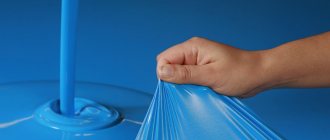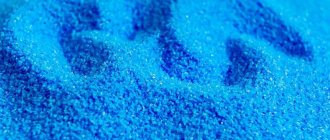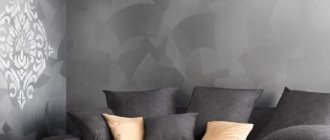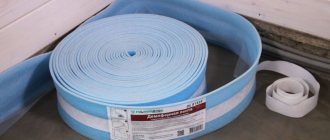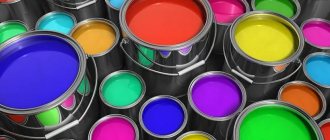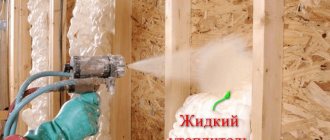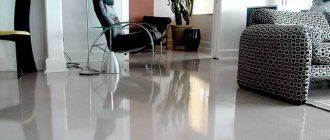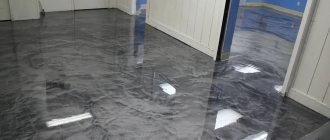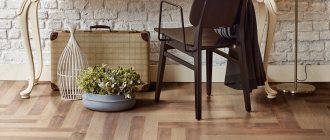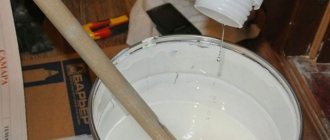What are the requirements for garage paint?
Let's start our story about how to paint a concrete screed in a motorhome by describing the basic requirements that the finishing layer must meet. After all, it performs not so much a decorative role as it is intended to make the floor resistant to wear and tear and remove dust.
The basic requirements are:
- experienced specialists will tell you that the paint should be durable: a wear-resistant coating will make using the garage more comfortable;
- Wear-resistant paint for a garage must dry quickly, not have a pungent, persistent odor, otherwise staying inside the building for some time can be harmful to human health and uncomfortable;
- fire resistance is an important criterion when choosing, because it determines the level of safety for a person and a car inside the garage;
- chemical resistance when interacting with various types of car care substances accidentally dropped on the floor must also be present;
- In order for the concrete screed to have a neat appearance and be easily cleaned of dirt, the coating must be chosen to be washable: then the painted layer will always look attractive.
There is no universal remedy that will fully meet all the described requirements. It is necessary to select the option with which to paint the cement floor inside the motorhome, taking into account the conditions of use of the building.
Types of dyes
The answer to the question of how to paint paving slabs is quite comprehensive. There are several types of dyes with different performance characteristics. Based on the method of use, they can be arranged into 2 groups:
- The agents that are introduced into the internal structure of the t are coloring substances added during the manufacture of tiles.
- Compositions that have a surface effect. Those with which the finished surface is processed.
Painted sidewalk at the dacha Source www.kraski.ru
How to paint the floor
Many car owners have no idea what and why it is worth painting concrete floors in the garage. Modern manufacturers create a wide selection of products with various characteristics and features of use.
Let us make a brief description of the main parameters of those materials that are most relevant for painting such surfaces.
But it is worth understanding that not every primer primer can be used as a self-dusting material. Two types of products are suitable.
Epoxy paint
Epoxy paint for concrete is a two-component composition that is mixed with each other and water using a drill. Apply in two layers. They are often used for garage floors, parking lots, and auto repair shops, as they allow the formation of strong, durable paint and varnish coatings that are resistant to external influences.
Polymer epoxy has the following advantages:
- high waterproofing capabilities;
- excellent indicators of resistance to aggressive auto chemicals: alkalis, fuels and lubricants, acids, salt solutions; low tendency to abrasion processes even with high trafficability of the structure;
- environmental cleanliness, harmlessness;
- Possibility of use outdoors and indoors;
- low consumption: 0.1-0.2 l/m2; · short hardening time: 12-24 hours, after which you can use the room to its full potential;
- resistance to fading when exposed to sunlight.
The disadvantages of epoxy dyes are the rather high cost and some difficulty in changing the color of the base if desired.
Acrylic paint
If the floor in the garage is painted with an acrylic composition based on organic and inorganic polymers, as well as acrylic resins, then the surface will be protected from mechanical damage and chemical exposure. The film that covers it will prevent negative factors from corroding the concrete. Two layers of material are applied.
Let us describe the advantages that acrylic products have for garage space.
Rubber paint:
- simple technology of use: surfaces are painted using a roller, brush, spray;
- environmentally friendly;
- dries quickly: 12-14 hours;
- low flow: 0.1-0.2 l/m2;
- characterized by low susceptibility to moisture, abrasion, chemicals, low temperature;
- resistant to abrasion, low temperatures and chemicals;
- features a wide variety of colors and types: glossy, matte, semi-matte;
- does not have an unpleasant odor. The only disadvantage of the acrylic product is its high cost.
Polyurethane enamel
We don't often paint concrete floors, so it's worth using a quality compound in the garage. One of the current options is two-component or one-component polyurethane enamel. Experts recommend using the first coloring agent inside the garage.
Advantages of polyurethane-based concrete paint for garage floors:
- high resistance to extreme temperature conditions;
- economical consumption;
- mechanical strength;
- wear resistance;
- low flow: 0.2 l/m2;
- resistance to auto chemicals, fuels and lubricants;
- low cost.
Polyurethane enamel also has disadvantages. It is applied only under certain conditions: at temperatures above +5 degrees Celsius, humidity less than 75%. Otherwise the coating will not harden. But if you wish, you can purchase much more expensive formulations that can be used at air temperatures from -5 to -30 degrees Celsius.
Rubber paint
Rubber paint for concrete is a new product in recent years on the domestic market, which has appealed to many car owners. The main advantage it has is its rapid hardening.
Already 30 minutes after application, provided the air temperature inside the motorhome is not lower than +20 degrees Celsius, the floors will harden. If you use the composition at a lower temperature, it will harden more slowly.
Rubber coloring material for concrete is similar in its main characteristics and components to polyurethane. Therefore, the coating can be created even inside a motorhome without a heating system.
Another advantage is the long service life: the base will not lose its basic characteristics for up to 10 years in a row. The material consumption is not very high, it is 400-500 g/m2. The material is applied in two layers using a brush or roller. The disadvantage of the composition is the high cost.
Recommendations for drying floors
Painting a concrete floor will be of high quality if you follow certain recommendations:
- it is necessary to paint concrete only when the air humidity inside the building is 70-80%, the air temperature is about +18 degrees Celsius;
- after applying the coloring composition, you cannot walk on the base until it completely hardens;
- It is necessary to clearly establish the period for complete drying of the product used, so carefully read the instructions for use on the container.
Manufacturers and reviews
An important step in selecting rubber paint is choosing a specific manufacturer of the mixture. Thus, solutions with similar purposes and composition, produced at different factories, will have their own specifics and exhibit similar qualities, but with some differences.
Rubber paint is manufactured by many companies from different countries, and here are some of them:
- AKTERM (Russia);
- Super Decor (Russia);
- lasti Dip (USA);
- Rezolux Universal (Russia);
- Rubber Paint (China);
- Farbex (Ukraine);
- Dali (Russia);
- Tikkurila (Finland);
- Jassar (USA);
- Promcolor (Russia);
- Kale (Türkiye).
A beginner will not be able to refresh a flat roof using fused roll waterproofing: such work will require many activities and the skills of good specialists. An excellent solution is acrylic rubber "AKTERM HydroStop" , which is applied cold using a brush or roller. This type of work does not require special skills.
"AKTERM HydroStop" is a one-component acrylic rubber material that not only creates surface waterproofing, but also protects against corrosion. The product can be applied to concrete, stone, wood, metal, brick and plastic. This liquid rubber is resistant to temperature influences, ultraviolet rays and precipitation.
The composition is safe and non-toxic; it is used both externally for roof waterproofing and indoors.
The consumption of AKTERM HydroStop depends on the porosity of the surface and ranges from 1 to 2.5 kg/m2. If there is strong porosity, the surface should be treated with acrylic primer before application.
The product must be applied in several layers of 1 mm using a spatula, roller or brush.
According to customer reviews, the products of the above companies dry quickly, adhere well, are easy to use, do not require a solvent, and do not fade in the sun.
Among the disadvantages, the need for thorough, scrupulous preliminary cleaning of the surface is noted. You should only paint outdoor surfaces in sunny weather.
In Russia, the first manufacturer of rubber paint was from St. Petersburg. This manufacturer has 12 years of experience in the production and sales of paints and varnishes. The Rezolux Universal line from Mizar is still the most profitable choice due to its increased coverage. Consumption is 120-150 g/m2. In terms of monetary costs, this is four times cheaper than another popular paint, Super Décor.
There are many inexpensive analogues of Mizar Rezolux Universal on the market. But almost all of them begin to crumble and crack in less than a month and even from exposure to sunlight (UV rays). This is a consequence of the presence of styrene-acrylic latex in inexpensive analogues of Mitsarov paints, which makes the products cheaper. But in the end, instead of rubber paint, the consumer receives only an imitation of it. Therefore, carefully read the composition - for example, Mizar Rezolux Universal does not use the mentioned type of latex. Therefore, the durable coating lasts up to 10 years. As a result, the coating from the St. Petersburg company, in terms of months, will last 120 times longer than slightly cheaper analogues.
It should be noted that Mizar paint and varnish materials are often used in complex industries and sensitive facilities. The state holding "United Shipbuilding Corporation" uses the company's materials to paint the surface and even underwater parts of military and civilian ships. Kola and Leningrad Nuclear Power Plants - Mizar enamels with special acid-resistant and anti-corrosion properties were used here.
Vast experience in the actual use of paints and varnishes under conditions of extreme atmospheric, chemical, mechanical and other loads allows the manufacturer to constantly improve products for ordinary consumers. Positive reviews of Mizar coatings also come from enterprises of the military-industrial complex, to which Mizar supplies products within the framework of the State Defense Order. Winning State Defense Order tenders are the result of the fact that Mizar’s materials meet special requirements for key characteristics (increased corrosion resistance and hiding power, minimal consumption, increased wear resistance). And at the same time they have the lowest price among all analogues.
Review of the best paints
We continue to talk about what paint to coat the concrete floor inside a motorhome. Which brand is the best?
On a concrete base, experienced specialists recommend using the following options:
- Teping P 1155 is an epoxy paint characterized by the highest level of abrasion resistance. It is used when the air humidity inside the building is no more than 90%, the temperature range is from 10 to 27 degrees Celsius. The optimal temperature for use is 22 degrees. The composition is able to withstand heavy loads - up to 220 kg/cm2;
- Temafloor is a two-component epoxy paint from the Tikkurila brand. Manufactured without solvents, it is suitable for painting new and old concrete floors, and can withstand temperatures up to +70 degrees. To create a dense, elastic paint film on the base, you will also need Temafloor Flex hardener;
- Polymerstone-1 is a polyurethane enamel that can be applied to the base at a humidity of up to 4% and a temperature of more than 5 degrees. It has high strength, practicality, and is used economically.
Chemical and technological characteristics
This product is an acrylic emulsion, which is made on a water-dispersion basis using acrylate synthetic latex - a material that has increased elasticity, is resistant to aggressive temperature conditions and is extremely low. Hygroscopicity.
In addition to water, the chemical composition of paint also contains:
- A coalescent is a special functional additive that provides increased adhesion of the applied layer to the surface of the treatment, and in addition, with natural evaporation (up to 96% in 3 hours at a temperature of +26 degrees) creates a protective outer film.
- An antifungal additive is a chemical compound that can destroy and prevent the growth of mold and pathogenic fungi for a long time.
- Antifreeze additive is a component that regulates the rate of hardening of the layer and actively resists aggressive temperatures.
- Coloring additive is a paste of different shades that contains an inorganic pigment with increased light resistance.
Operational and technical characteristics
Rubber paint for concrete floors has the following characteristics:
- Able to withstand temperature changes from -55 degrees to +50 degrees (some types can withstand from -82 to +80 degrees).
- Insensitive to environmental influences.
- It has increased adhesion properties, which helps ensure high quality adhesion of layers to the processing surface.
- Once the paint is completely dry, it is non-slip.
- It has no reserve and is non-toxic; you can perform work without using a respirator.
- Has fire resistance.
- Matte (if you plan to use it for roofing work, semi-matte).
- It tolerates cleaning well, even if you use a brush, water, alkaline, antiseptic and other detergents.
When everything is completely dry, the surface treated with paint feels like soft rubber, rubber, and its elasticity is at least 360%.
The advantages of rubber paint for concrete garage floors is that the weight to volume ratio is 1.1 kg = 1 liter of paint. One layer, which has an average thickness of 50 microns, will harden completely in 12 hours, and will stop sticking after a couple of hours at a room temperature of 25 degrees. Dry residue can be up to 50%. The warranty period for use of the coating is 10 years (if the paint is wear-resistant, then 20 years). The shelf life of the product in a closed container is up to 3 years, and after opening for another six months. The storage conditions for rubber paint for concrete floors are as follows: from -5 degrees to +25. When freezing and cooling (no more than 5 cycles in 1 month at a temperature of -20 degrees), the paint can be defrosted, and for this you need to leave it at room temperature for at least a day. Before use, be sure to stir it until the bottom sediment disappears.
Properties and characteristics
The mixtures currently produced are widely used. The popularity of rubber paints among consumers is ensured by such properties as:
- Water resistance
. Acrylic-based compositions can be used in conditions of high humidity; in addition, the paint can be used as waterproofing for swimming pools, floors, roofs, etc.; - Durability
. The use of paint on summer sports grounds, open stadiums, and bicycle paths has shown that such a coating does not lose its original properties for 8 years or more. In addition, peeling in a small area can be easily eliminated by applying a new coat of paint; - Elasticity
. This property makes it possible to use the composition on surfaces subject to vibrations and minor periodic shifts. The ability to deform prevents cracking and peeling of the coating, which is an undeniable advantage over traditional paints and varnishes; - Environmental Safety
. The use of water as a solvent completely eliminates the harmful effects of paint on the human body, and the acrylic base does not cause any allergic reactions. It is allowed to work with the composition even in unventilated areas. - Frost resistance
. With full compliance with the dyeing technology, rubber coatings can be used in the temperature range from -65 to +550C without losing their original characteristics. In case of freezing, it is enough to place the jar in a warm room for a day, after which the composition can be used again. - Versatility
. Rubber paint can be applied to almost any surface, both indoors and outdoors. You can paint concrete, brick, metal surfaces, wood, tiles and ceramic tiles. - Affordable price
. The purchase will not cause serious damage to the family budget. The cost of a can of paint, depending on the manufacturer, ranges from 350 to 450 rubles.
When using the material, you should take into account its main technical characteristics:
- The use of thinners
is allowed only when absolutely necessary; - Primary polymerization time
ranges from 30 to 60 minutes, complete hardening can last from 1.5 to 3 hours, depending on humidity and temperature; - Dry residue
is 45% or more; - The specific gravity
of 1 liter of paint, depending on the consistency, can range from 1 to 1.2 kg. - Resistance to washing
is high. The coating can be washed using cleaning products and a medium-hard brush; - The instrument
can be cleaned with a soda solution, water and soap, or household detergents; - Weather resistance is high, even in aggressive environments;
- The composition
should be stored in tightly closed containers, avoiding freezing, the guaranteed shelf life is 2 years from the date of release;
After complete drying, the surface has a characteristic semi-matte shine.
Application and features of interaction with various materials
Despite the name that is indicated on the container for the roof, for metal, for concrete, all these types of paint have practically the same properties, the only difference is that roof paint has more active pigments, and concrete paint has more antifreeze and acrylatex , and metal paint contains more coalescent.
Exceptions are expensive paints of the best quality, as their warranty period is from 25 to 30 years, since it is considered truly resistant to wear. Such a definition as for external use is also not a complete enough description of the intended purpose of the paint, because its practical use is much wider.
It turns out that any rubber paint with a shelf life of 10 years or more is intended for a whole range of works, and among them we highlight:
- Basement and facade work, this also includes work with concrete, brick, gypsum, cement, plastered (without the use of slaked lime) putty surfaces.
- Painting roofs and other objects that are faced with clay and metal tiles, asbestos-cement slate, corrugated sheets, galvanized iron, ondulin, and tin.
- Indoor work on painting putty and plastered walls, plasterboard, non-woven, vinyl and other non-paper based wallpaper, chipboard and fiberboard.
- Used to reduce slipping to cover ramps, pools, and inclined surfaces.
Important! For painting surfaces that are constantly exposed to mechanical stress - running tracks, courts, playgrounds, pedestrian crossings, etc., it is better to use special paints with an extended shelf life - from 20 to 30 years.
The water resistance of rubber paint has made it an almost indispensable material for arranging a home pool.
- Application on wood surfaces that are constantly exposed to aggressive light and temperature, such as canopies and benches exposed to the sun. For interior work, it can only be used for painting the bathroom and toilet room.
- After preparation, it is possible to paint surfaces that were previously coated with alkyd or oil paints.
Helpful advice! The prohibition on using the emulsion as a coloring product for furniture and floors is a recommendation from the manufacturer, but experience shows that after proper preparation, the coating begins to withstand application to the floorboards of an outdoor gazebo. Based on this, the use of environmentally friendly and non-toxic paint for the purposes described above is a personal matter for each owner of a private home.
Recommendations:
- It is not recommended to use paint on breathable surfaces - furniture, interior floors, walls, as hydrophobic additives will prevent the exchange of air and the release of condensate formed.
- Do not use on surfaces that have a layer of slaked lime whitewash on them, as the latex paint base will simply roll off the lime.
- The paint has a reduced level of hiding power, and therefore should be applied in 2-3 layers.
Now it's worth considering how to prepare for painting a concrete floor with rubber paint.
Application
The scope of application, as well as the consumption of rubber paint when painting various surfaces, is clearly presented in the table.
| Surface to be painted | Consumption, g/m2 |
| 250 |
| 300 |
| 350 |
| 400 |
| 450 |
Based on the information given in the table, you can accurately calculate the required amount of material for painting any surface.
What are the requirements for garage paint?
To decide how to remove dust from a surface, you must consider the following requirements. The coloring composition should be:
- wear-resistant;
- fire resistant;
- weatherproof;
- quick-drying;
- chemically resistant;
- washable.
There is no universal product for painting cement floors that equally meets absolutely all these requirements, so the composition is selected based on the conditions of use of the room.
Important! It is strictly forbidden to use oil-based, alkyd or organofluorine paint to paint a concrete garage floor. Such materials change their chemical composition upon contact with fuels, lubricants and petroleum products.
Let's consider all the options for painting materials that are most often used for dust removal of floor coverings.
Epoxy paint
Epoxy paints for concrete are most often two-component compositions that are mixed with each other and water (no more than 20%) using a drill immediately before applying the material. This substance forms a highly durable and durable coating on the surface that is resistant to external influences.
Among the advantages of such paints it is worth highlighting:
- waterproofing properties;
- high resistance to aggressive chemicals (alkalis, fuels and lubricants, acids and salt solutions);
- abrasion resistance;
- environmental friendliness;
- resistance to fading;
Among the disadvantages, one can note the rather high cost of the material. In addition, it will be very difficult to change the color of the surface later.
Epoxy concrete paint is suitable for garages, hangars, auto repair shops, parking lots, workshops and much more. It can be used for both internal and external processing. The paint consumption will be about 0.1-0.2 l/m2, and the hardening time will vary from 12 to 24 hours, depending on the manufacturer. Epoxy paint for concrete floors is applied in several layers. You can walk on the surface within a day.
One-component epoxy quick-drying paints are also available on sale. Before using such materials, it is necessary to prime the floor.
For which roofs is rubber coating suitable?
Acrylic paints and varnishes are suitable for all popular types of roofs. Moreover, some of them simply need them. Metal tiles are protected from corrosion at the production stage. The service life of the paint that covers the tiles is very short. This nullifies all the manufacturers’ assurances about the durability of the material. But if you regularly cover such a roof with an additional layer of acrylic paint, you can extend its service life.
Slate does not rust, which creates a misconception about it as an “eternal” material. Slate is easily saturated with moisture, becomes brittle and collapses. The waterproofing properties of rubberized paint make asbestos-cement sheets impervious to moisture.
A corrugated roof also needs protection
Galvanized profiled sheets are afraid of salt, since the coating easily enters into chemical reactions and is destroyed. Considering the state of the environment, galvanizing is constantly exposed to an aggressive chemical environment. Rain, snow, and regular exhaust gases can damage galvanized metal. Acrylic coating protects this type of roof well.
Soft roofing can also be painted with acrylate latex paint. Soft roll roofing has a short service life, is easily damaged, drys out and cracks. To “bring to life” a roof covered with roofing felt, it is enough to paint it with moisture-proof paint. With such protection it will last longer.
The difference is obvious
Acrylic paint
The basis of such paints are organic and inorganic polymers and acrylic resins, which form a durable film on concrete that prevents mechanical damage and chemical influences.
Acrylic paints for concrete floors have many advantages:
- ease of application (when painting, you can use a roller, brush or spray);
- environmental friendliness;
- drying speed;
- immunity to moisture;
- resistance to abrasion, low temperatures and chemicals;
- a large selection of colors and types of paint (glossy, matte or semi-matte);
- no unpleasant odor.
The only drawback of this paint is its high cost.
Such compositions dry in 12-14 hours (you can walk on the floor after 48 hours), and the consumption of paint and varnish material is 0.1-0.2 l / m 2.
Some manufacturers claim that acrylic paint for a concrete garage floor can be applied in one layer, but according to practice, it is better to play it safe and apply several layers of the material.
Acrylic paints are great for treating floors in garages, basements and balconies.
What is required from a concrete screed
In order for the selected paint to behave as stated by the manufacturer and expected by the consumer, the concrete base must meet certain requirements.
It is clear that the screed itself, with its strength characteristics, must meet the conditions of garage operation. The best option for arranging a garage floor would be concrete of grade M300 strength. It is made from Portland cement PC400, crushed stone and sand, taken in a proportion by weight of 1.0: 3.7: 1.9.. or by volume 1.0: 3.2: 1.7.
If you paint old floors that have cracked or have potholes, then the paint will not only not be able to hide these flaws, but it will not stay on such a surface for a long time. With such a careless approach to coloring, all financial investments, as well as the time and effort spent, will be in vain. That is, identified defects in the concrete surface must be repaired before applying paint.
Therefore, before you start choosing paint for the garage, you need to inspect the base. And if necessary, make a complete or at least partial repair of the surface.
Prices for concrete floor paint
concrete floor paint
Polyurethane enamel
This concrete floor enamel can be two-component or one-component (for a garage it is better to give preference to the first type). Such compositions are used for both external and internal decoration.
The advantages of such a paintwork include:
- high stability in extreme temperature conditions (the composition tolerates temperatures from -60 to +80 degrees);
- efficiency;
- mechanical strength;
- wear resistance;
- resistance to chemicals and fuels and lubricants;
- low cost.
Among the disadvantages is the capriciousness of the paint, which can only be applied if the room temperature is not lower than +5 degrees and the humidity is not more than 75%. Otherwise, the composition will not set.
Healthy! There are compositions on sale that can be applied in severe frosts (down to -30 degrees), but their cost will be more than 400 rubles per 1 liter.
Also, the disadvantages of polyurethane compositions include the paintwork taking too long to dry. The first layer of paint takes a day to set, and after covering the floor with the second layer, you will have to wait another 14 days, only after that you can walk on the floor.
The consumption of such floor paint on concrete is up to 0.2 l/m2. Such compositions are used for painting floors in garages, gyms, swimming pools, parking lots and car washes.
Rubber paint
When determining how to paint a concrete floor in a garage, you can purchase rubber paint, which has appeared on the construction markets recently, but has already gained popularity among consumers. The main advantage of this composition is that it hardens within half an hour at a temperature not lower than +20 degrees. However, this does not mean that you can only paint the floor at above-zero temperatures. This type of paint can be safely applied on a frosty day (up to -30 degrees), the only difference will be in the drying speed of the paintwork.
Rubber paint for concrete floors resembles polyurethane painting material in its properties and composition. Thanks to this, such a coating can be safely used at temperatures ranging from -50 to +60 degrees in unheated rooms.
Another advantage of this composition is its long service life (10 years). Material consumption does not exceed 400 g/m2. The paint is also applied in two layers using a brush or roller.
The only disadvantage we can highlight is the rather high cost of the coloring composition. If you want the cheapest way to paint your concrete garage floor, you can use an epoxy or polyurethane primer as a protective coating.
Colors
Rubber paint is available in the following colors:
- white;
- blue;
- light green;
- beige;
- yellow;
- blue;
- brick;
- green;
- cherry;
- black and other colors.
If necessary, the color can be changed by adding a tinting additive - pigment.
Primer for concrete floor
Typically, before painting, a rough coat of primer is applied to the surface, designed to better adhere the paint and varnish material to the concrete surface. However, some primer compositions can be completely used as independent dust removal materials. In the case of a garage, where the aesthetic component does not play the most important role, this solution becomes the most profitable.
Not every primer is suitable for such purposes; only two types of compounds can be used for garage floors.
Polyurethane primer has the following advantages:
- fills voids in concrete, making the surface more durable and even;
- has high adhesion;
- easy to apply;
- is a quick-drying material;
- It is resistant to aggressive chemicals and machine oil.
You can also use an epoxy primer that:
- forms a durable glossy film on the concrete floor, which does not fill, but closes the pores of the cement screed;
- is waterproof and resistant to aggressive chemicals;
- does not wear out and retains color for a long time.
As for paint coating manufacturers, there are a number of compositions that experts recommend using.
Why paint your garage floors?
If the floor surface is strong and reliable, then maybe it’s not worth covering it with a protective layer? This question arises for many car enthusiasts. Still, it’s an extra expense of both money and time...
Therefore, it is worth specifying the factors that will determine the reasons proving the need to protect the concrete surface from various external influences.
Despite the fact that at first glance the screed looks strong and monolithic, it has a porous structure. This is due to the fact that concrete is heterogeneous and is made from various components that differ in their physical characteristics. As the screed matures, microscopic pores and cracks form in its structure. The crystalline bonds of the cement stone are intersected by insoluble solid inclusions. There is no escape from the smallest air bubbles involved in the solution during the mixing process. All this contributes to surface erosion of hardened concrete and the formation of dust. Moreover, it is the surface layers of the screed that have the least stability. In a garage, where floors are exposed to various influences, including shock and abrasion loads, there is a high probability of rapid erosion destruction of the concrete base in the absence of proper protection.
An unpainted concrete floor is always covered with fine cement dust, which you have to breathe in while doing various jobs. It is almost impossible to get rid of small dust particles, since they appear due to friction that occurs even during normal walking on the surface.
Painting the concrete floor in the garage saves the owner from many unpleasant problems
Properly selected paint and adherence to the technology for applying it to a concrete screed solves almost all of the problems listed above. This processing gives the following:
- Strengthening strength characteristics and wear resistance.
- Increased resistance to the destructive effects of chemical compounds.
- No dust on the surface.
- Inert to external moisture, since the pores of the surface of the material are filled with a painting composition.
- Increased service life of the screed, as erosion phenomena are sharply reduced.
- Simplification of cleaning activities, as well as reduction of time for their implementation.
Experts have proven that correctly selected colors in the design of work spaces directly affect a person’s performance.
- More aesthetic appearance of the room. By the way, this is important not only from the standpoint of “naked aesthetics.” You can choose an interesting color or even several shades of it that will lift your spirits while working, thereby increasing productivity and the quality of the results obtained.
From all the arguments presented, a logical conclusion arises. Painting will protect the screed from many damages. This means that the garage owner will be spared the need for major floor repairs and frequent and dirty cleaning. And favorable conditions for carrying out various works will be created in the room.
Review of the best paints
Experienced specialists prefer the following brands of concrete paints:
- Teping P 1155. This solvent based epoxy has the highest abrasion resistance. It is recommended to use paint when the humidity of the room is less than 5%, the air is no more than 90% and the temperature is from 10 to 27 degrees (it is best to carry out work at a temperature of 22 degrees). Composition P 1155 can withstand quite heavy loads (up to 220 kg/cm2), and is resistant to moisture, detergents and fuels and lubricants. Paint consumption will be 20 kg per 37 m2 if paintwork is applied in two layers. The paint costs 8,000 rubles (for a set of base and hardener).
- Temafloor A two-component epoxy composition from the well-known manufacturer Tikkurila does not contain solvents. This brand of paintwork is suitable for painting both new and old concrete floors, as well as surfaces to which paint components have already been applied. The composition can withstand temperatures up to +70 degrees, suitable for external and internal processing. To obtain a flexible paint film on the floor, it is also recommended to purchase Temafloor Flex hardener. Material consumption is 1 liter per 6-8 m2, depending on the number of layers applied. The price of Temafloor 150 will be about 750 rubles per liter.
- Polymerstone-1. This polyurethane enamel is applied to the surface at a humidity of no more than 4% and a temperature of no lower than 5 degrees. The composition itself, after drying, can withstand from -50 to +100 degrees. The resulting paintwork is characterized by increased strength and resistance to moisture and chemically aggressive substances. Material consumption is 0.4 kg per 1 m 2. The price of paint is about 3,400 rubles per 7 kg.
You should also pay attention to the following compositions:
Having chosen what to paint the garage floor with, all that remains is to apply the selected composition to the surface according to the instructions on the package and wait until the screed is completely dry.
Recommendations from experts
Roofing paint can be
applied at an optimal temperature
equal to the range of +10-25C.- It is not recommended to apply paint in direct sunlight
- Painting should not be carried out in the rain
. Do not apply paint and varnish material to a wet surface. - If you need to use a solvent
, then you need to choose the one specified by the manufacturer in the instructions. - The applied layer must dry within the time
specified by the manufacturer. Only after this is the second coating applied. - The paint should be applied evenly in a thin layer
. Leaks must be avoided.
